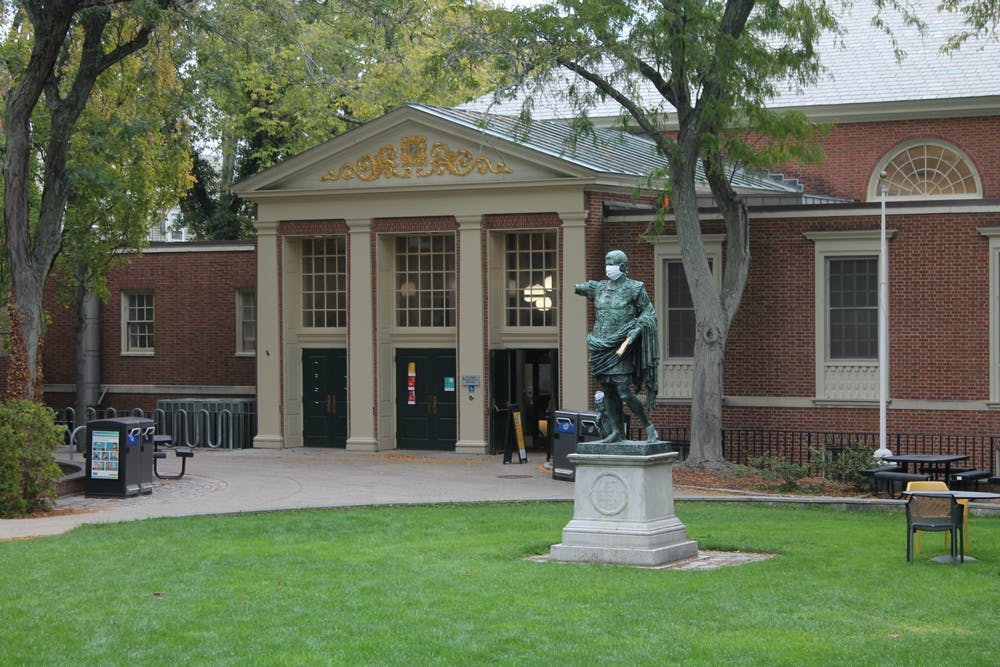University community members will gain access to a virtual version of their Brown IDs by next fall that allows them to pay with meal credits, points or Bear Bucks at dining halls. They will also have access to recreational facilities and the Brown Shuttle, without needing their physical IDs, according to a Thursday morning Today@Brown announcement.
The virtual IDs, which will be accessible on smartphones, do not make physical Brown ID cards obsolete. According to the announcement, students will still need to physically swipe their cards to enter buildings with card access, make purchases from vending machines and pay for laundry.
But introducing virtual IDs — part of a broader shift to Atrium, a cloud-hosted “campus card management solution,” by the Office of Information Technology and Brown Dining Services — will open up a number of new possibilities and make the dining experience “much more efficient,” said Vice President of Dining Services George Barboza.
By September, BDS expects that the shift to Atrium will make mobile ordering available to all community members following a two-week beta test of a new platform in the Blue Room, according to the announcement.
BDS chose the Blue Room as the test site in an effort to allow “constituents across the spectrum” to try out mobile ordering, Barboza said.
“We want to do the testing and see how it flows — see the capacity the staff has for mobile ordering as well as entree ordering,” Barboza said. “As that rolls out, we will learn more.”
“The main goal is to enhance the end-user experience,” Barboza added. “The systems that we had were outdated and a little antiquated.”
“This is a leap in technology,” said Geoffrey Greene, OIT director of departmental systems. According to an FAQ provided by the OIT, the software that the University currently uses for “declining balance and meal plan management functionality” is over 16 years old, making it unable to “effectively integrate” with other systems on campus.
According to the announcement, a “new, mobile responsive website” will allow community members to generate a virtual ID, add funds, view account balances and, during “prescribed timeframes,” change meal plans. That system, run by Atrium, will replace the GET portal, though all Bear Bucks balances will transfer across the platforms, according to the announcement.
Beth Gentry, vice president of business and financial services, explained that the new IDs will look similar to students’ physical IDs, with a front and back side that flip with a tap of the screen.
The front, Greene explained, will include a dynamic barcode that changes with each use; the back will include the same physical barcode that is found on the front of physical IDs.
In “all you care to eat” dining halls, he added, the virtual barcode will likely speed up lengthy queues to enter at peak hours. Instead of swiping a card, students would scan their phone at a reader — a process that Gentry compared to presenting a mobile ticket to a Transportation Security Administration official at an airport. There is not yet a set timeline to implement the virtual barcode at dining halls.
A cashier will still oversee the process, Barboza noted — but one cashier might be able to oversee multiple readers.
“We’ve had real struggles with getting 100% (of staff positions) filled,” he explained. “Nobody will lose their job.”
Barboza, Gentry and Greene emphasized that the Atrium system will have a number of other functions, such as adding funds for printing, entering sporting events where a Brown ID functions as a ticket and buying dining points.
While Brown allotted funding to modernize its ID system last May, the University had been discussing changing its systems for a “couple of years,” Barboza said.
The University selected Atrium after several potential contractors submitted proposals to the Strategic Sourcing Office, Gentry explained.
Atrium, Barboza said, fit all of the University’s requirements for dining services functionalities such as mobile ordering. Their system is also “by far the most flexible” technically, Greene noted.
And though the virtual system won’t confer physical access to buildings, Greene added that he, along with a number of people across the University, are “looking to move forward with a new version of the physical card.”
“We are very much thinking about access control, entry to building and facilities — how to get that to be a proximity or tap-based entry with your physical Brown ID card, eventually looking to the smartphone as your answer there,” Greene said.
While physical access is not part of the shift — and would not include services from Atrium — the University still had to look at the future of physical access to buildings “in concert” with the introduction of the virtual ID, according to Greene.
The virtual ID “is still not ready for building access, but it’s moving us in a new direction,” Gentry said.
The University will engage in targeted communication to some groups, including students living in residence halls over the summer, to provide additional information about the new system, according to the announcement. Further Today@Brown communications will outline the process of generating a virtual Brown ID, as well as required steps as user features such as Bear Bucks accounts shift to new platforms, Gentry said.
Gentry added that as the University learns more about the small steps involved in the broader transition to Atrium, they’ll share them with the Brown community. “Keep aware,'' he said, “there’s things coming.”

Will Kubzansky was the 133rd editor-in-chief and president of the Brown Daily Herald. Previously, he served as a University News editor overseeing the admission & financial aid and staff & student labor beats. In his free time, he plays the guitar and soccer — both poorly.





